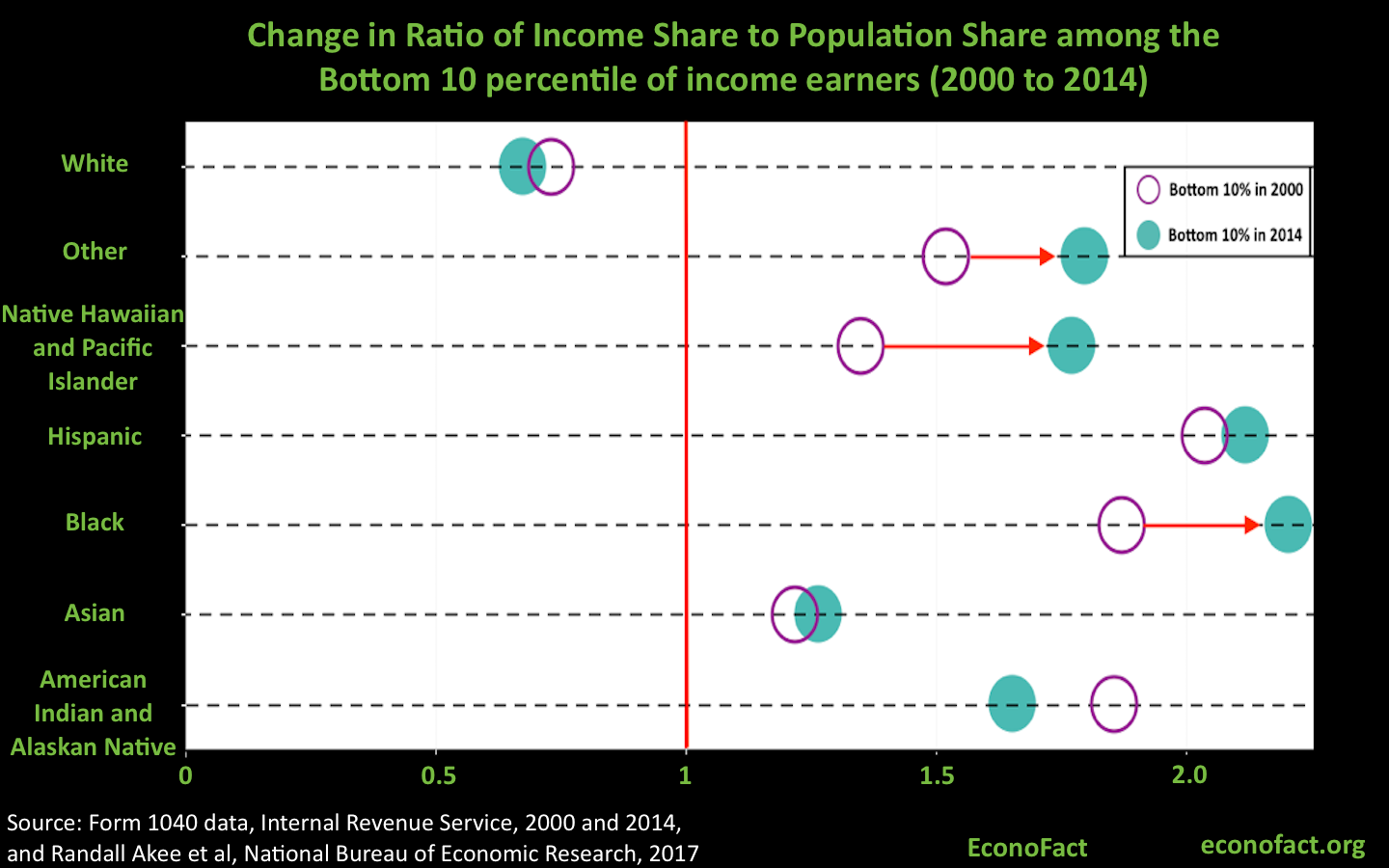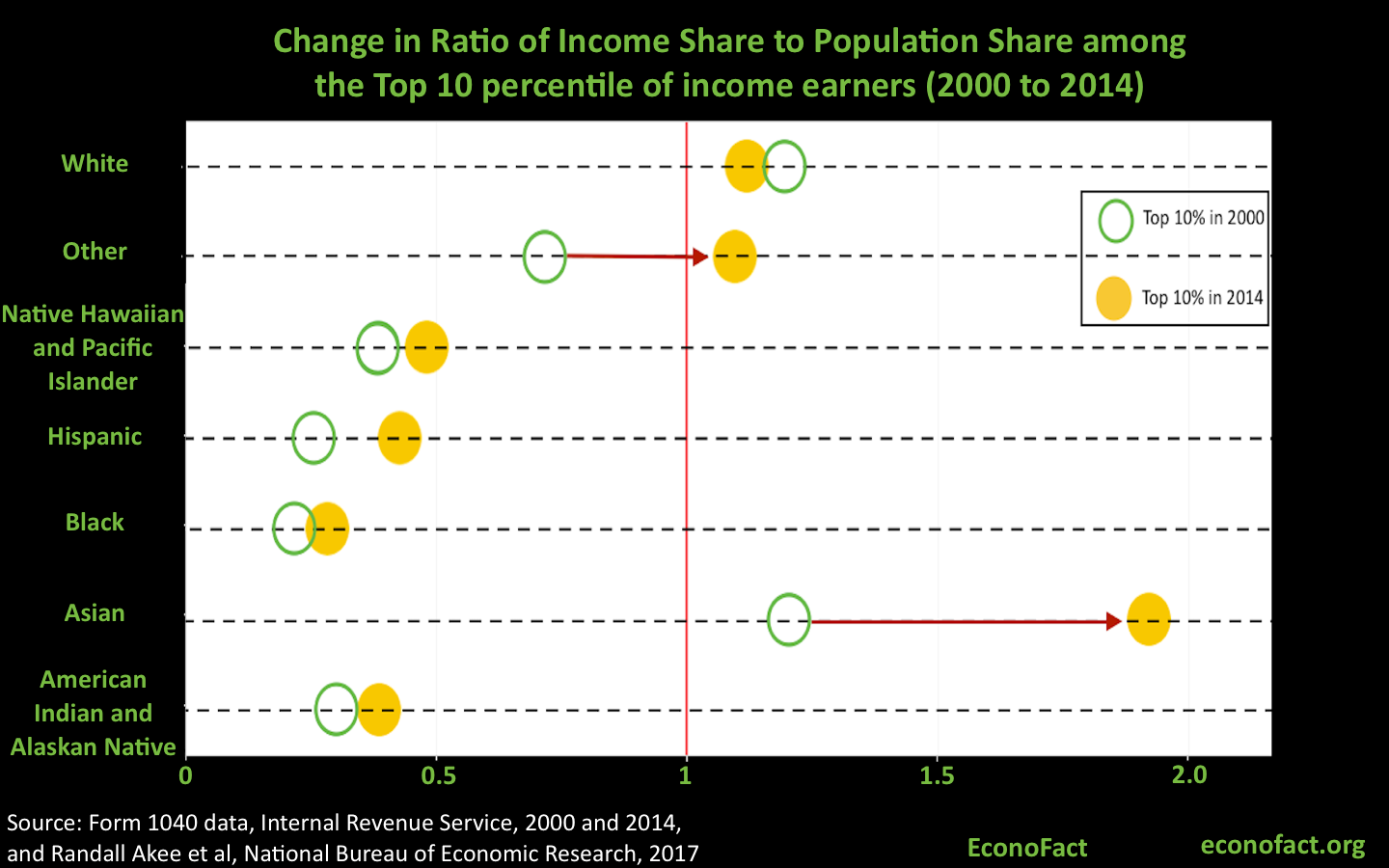Race and Ethnicity Within Widening Income Inequality in the United States
University of California, Los Angeles
(A ratio of 1 means representation in the top 10 percent is commensurate with a group's representation in the overall labor force. A ratio greater than 1 represents an overrepresentation of that group in the top decile and a ratio of less than 1 represents an underrepresentation).
The Issue:
There are significant and longstanding differences in income between racial and ethnic groups in the United States. At the same time, income inequality has been on an upward trend in the United States over the past 30 years. However, relatively little is known about what is happening with the differences between racial and ethnic groups in the context of widening inequality. Is growing inequality exacerbating the differences between racial and ethnic groups? Are some groups seeing better outcomes than others?
The disproportionate amount of income accruing to the top of the income distribution is also accruing disproportionately to a few race groups.
The Facts:
- The richest 10 percent of the population earn over 40 percent of total annual earnings in the United States, whereas the poorest 10 percent receive about 1 percent of national income. The divergence in the concentration of income has been increasing over the past few decades. After the Gilded Age, the Great Depression and World War II, the United States experienced a long period of economic growth that was relatively evenly spread across the various parts of the income and skill distribution. However, this changed dramatically in the 1970s as income inequality started to increase to levels not seen in 50 or 60 years (see here). Annual Gini coefficient measures for earnings — used to gauge the distribution of earnings — have increased by 10 points (0.36 to 0.47) from the 1940s to the 2000s indicating that earnings income is more concentrated than previously; this level of inequality surpasses the levels of inequality in the Great Depression and World War II eras (see here).
- While there have been ample studies of income inequality in the United States, data limitations have made it difficult to consider how racial and ethnic characteristics factor in the picture. This is especially true for some of the most economically marginalized populations of the United States, such as American Indians and Pacific Islanders. Research using only information from Social Security Administration records or tax filings — frequently used for studies of inequality — cannot provide insight on racial or ethnic inequality because they do not contain measures of race or ethnicity. Alternatively, existing survey data often has too few observations for small racial and ethnic groups and are unable to provide information on inequality for these groups over time. In order to address these shortcomings, my co-authors and I were able to link information from the U.S. Census — which contains racial and ethnic information for individuals — with their income information available in tax records in a recent study. This confidential-use data has more than 100 million annual observations of tax filers – including the race and ethnicity of each filer – over a 15-year span for 2000 to 2014. Because of its size, the data allow studying with a degree of confidence the outcomes for racial and ethnic groups that makeup a very small share of the U.S. population, such as American Indians/Alaska Natives (AIAN), Native Hawaiians/Pacific Islanders (NHPI) and Other Races/Multi-Race. The Other Races/Multi-Race category is a catchall for individuals who self-identify as multi-racial and for those in races other than those identified here.
- Whites have been, and continue to be, disproportionately represented among the wealthiest 10 percent of the population. One simple measure that gives a sense of the relative standing of different racial and ethnic groups in the national income distribution is looking at whether the share of each group at the top and bottom of the earnings distribution is proportionate to the group's share in the total population. For example, Whites accounted for almost 90 percent of income earners at the top 10 percent of the income distribution in 2000, but made up only about 75 percent of the overall labor force that year, a ratio of 1.2 (see chart). By 2014, Whites continued to be overrepresented in the top 10 percent. (A a ratio of 1 means representation in the top or bottom 10 percent is commensurate with a group's representation in the overall labor force. A ratio greater than 1 represents an overrepresentation of that group in either the top or bottom decile and a ratio of less than 1 represents an underrepresentation in that decile). Clearly this is a very simple measure and does not account for sources of differences across groups, such as differences in education. However, there is probably little difference in these factors at the upper and lower ends of the income distribution.
- Between 2000 and 2014, Asians significantly increased their representation in the top 10 percent of the income distribution. Asians are the only other group overrepresented in the top 10 percent of the income distribution in 2000. Moreover, Asians realized a relatively large increase in their share of total income in the top 10 percent over the 2000-2014 period. The "Other Race" category was underrepresented among the top 10 percent in 2000 but by 2014 this group received more income than its proportionate share.
- All racial and ethnic minority groups are disproportionately represented in the bottom 10 percent of the income distribution. The degree of overrepresentation increased for almost all the groups between 2000 and 2014. All groups with the exception of non-Hispanic Whites are more than proportionately represented at the bottom end of the income distribution. The fact Asians as a group are more than proportionately represented both at the top and the bottom of the income distribution implies that the Asian Category has the most widely dispersed income levels of all groups. This category includes all individuals of Asian descent from the Far East, Southeast Asia, and the Indian subcontinent. (In future research, we intend to further disaggregate this category into its constituent parts to identify which sub-groups are driving these differences).

(A a ratio of 1 means representation in the bottom 10 percent is commensurate with a group's representation in the overall labor force. A ratio greater than 1 represents an overrepresentation of that group in the bottom decile and a ratio of less than 1 represents an underrepresentation).
What this Means:
Not only are disproportionately large amounts of income accruing to the top end of the income distribution, it is also accruing disproportionately to a few race groups. Overall, there is significant variation in the representation at the top and bottom of the income distribution across racial and ethnic groups. There was a relatively large change of the ratios in the top 10 percent of the Asian and Other groups, but a relative persistence, or even growing overrepresentation, among all but one of the non-White groups in the lower 10 percent. The statistics presented here cannot address the sources of these differences across racial and ethnic groups and, therefore, the role of factors such as education, experience or changing industrial and occupational labor demand. Nevertheless, these statistics demonstrate stark differences across racial and ethnic groups and may point to sources of disparity beyond strictly economic ones.

